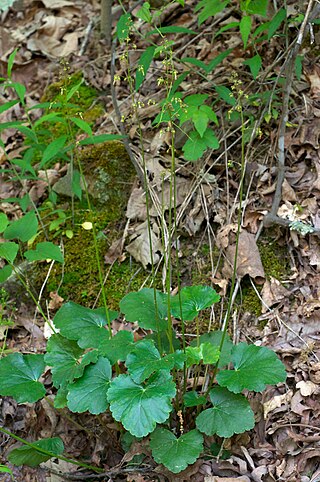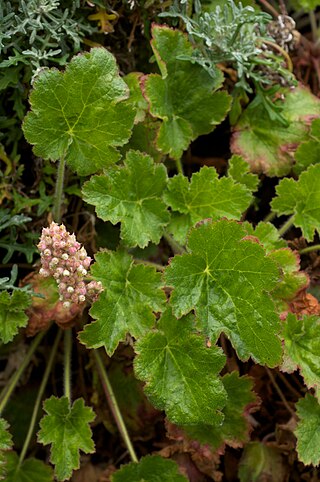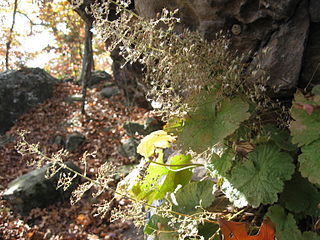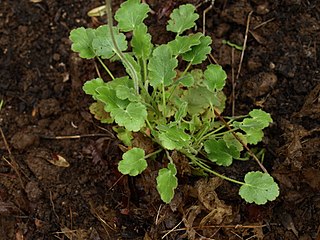
Sir John Richardson FRS FRSE was a Scottish naval surgeon, naturalist and Arctic explorer.

Heuchera is a genus of largely evergreen perennial plants in the family Saxifragaceae. All species are native to North America except for Heuchera sichotensis, native to the Russian Far East. Common names include alumroot and coral bells.

Heuchera americana, or American alumroot, is a small evergreen perennial native to eastern and central North America while also ranging into Ontario, Canada. It is a part of the Saxifrage family.

Heuchera rubescens, with the common name pink alumroot, is a species of Heuchera.

Heuchera abramsii is a rare species of flowering plant in the saxifrage family known by the common names San Gabriel alumroot and Abrams' alumroot.

Heuchera brevistaminea is a rare species of flowering plant in the saxifrage family known by the common name Laguna Mountains alumroot. It is endemic to the Laguna Mountains of San Diego County, California. It grows in rock crevices and steep cliffsides in chaparral and yellow pine forest habitats. This is a rhizomatous perennial herb producing an inflorescence up to 25 centimeters tall. The flowers are bright pink or magenta.

Heuchera elegans is a species of flowering plant in the saxifrage family known by the common name urn-flowered alumroot.

Heuchera hirsutissima is a species of flowering plant in the saxifrage family known by the common name shaggy-haired alumroot.

Heuchera maxima is a species of flowering plant in the saxifrage family, known by the common names island alum root, Channel Islands coral bells, and Jill of the rocks.

Heuchera merriamii is a species of flowering plant in the saxifrage family known by the common name Merriam's alumroot. It is native to the Klamath Mountains of southern Oregon and northern California, where it grows on the rocky slopes. This is a rhizomatous perennial herb producing a patch of leaves which are rounded and have five to seven lobes along the edges. It produces an erect inflorescence up to about 23 centimeters tall with sparse clusters of pinkish, yellow, or cream flowers. The inflorescence is covered in glandular hairs. Each flower has small spoon-shaped petals and protruding stamens.

Heuchera micrantha is a species of flowering plant in the saxifrage family known by the common name crevice alumroot, or small-flowered alumroot.
Heuchera parishii is a species of flowering plant in the saxifrage family known by the common names Mill Creek alumroot and Parish's alumroot. It is endemic to California, where it is found in the San Bernardino Mountains. This is a rhizomatous perennial herb producing a patch of lobed, kidney-shaped leaves up to four centimeters wide. It bears an erect inflorescence up to about 27 centimeters in height which blooms in dense clusters of salmon-pink flowers. The plant gets its common name from Mill Creek.

Heuchera pilosissima is a species of flowering plant in the saxifrage family known by the common name seaside alumroot and Parish's alumroot. It is endemic to the northern two thirds of the California coastline, where it grows on coastal bluffs and in nearby forests. This is a rhizomatous perennial herb producing lobed oval-shaped leaves 4 to 9 centimeters wide, each on a long petiole. The erect inflorescence reaches over half a meter in maximum height and is covered in glandular hairs. It bears dense clusters of rounded, hairy flowers. Each flower has pink or yellowish lobes tipped with small white or pink petals. The stamens and stigma protrude from the narrow mouth of the flower.

Aquilegia laramiensis is a species of flowering plant in the buttercup family known by the common name Laramie columbine. It is endemic to Wyoming in the United States, where it is known only from the Laramie Mountains.

Heuchera parviflora is a species of flowering plant in the saxifrage family known by the common names cave alumroot and littleflower alumroot. It is native to the eastern United States, where it is found primarily in the Ozark Mountains, Appalachian Mountains, and Cumberland Plateau. It is found in deeply shaded areas such as under rock overhangs and cliffs, almost always where no direct sunlight falls. In this habitat, it is often the only vascular plant found. H. parviflora is an uncommon species throughout its range. It flowers in late summer through fall.
Heuchera eastwoodiae is a species of flowering plant in the saxifrage family, Saxifragaceae. It is endemic to Arizona in the United States, where it is found in Gila, Maricopa and Yavapai Counties. It is known by the common names Senator Mine alumroot and Eastwood alumroot.

Heuchera cylindrica is a species of perennial flowering plant in the saxifrage family known by the common names poker alumroot,roundleaf alumroot, and coral bells. It is native to western North America, where it is found from British Columbia to California, and east to Wyoming and Montana.















